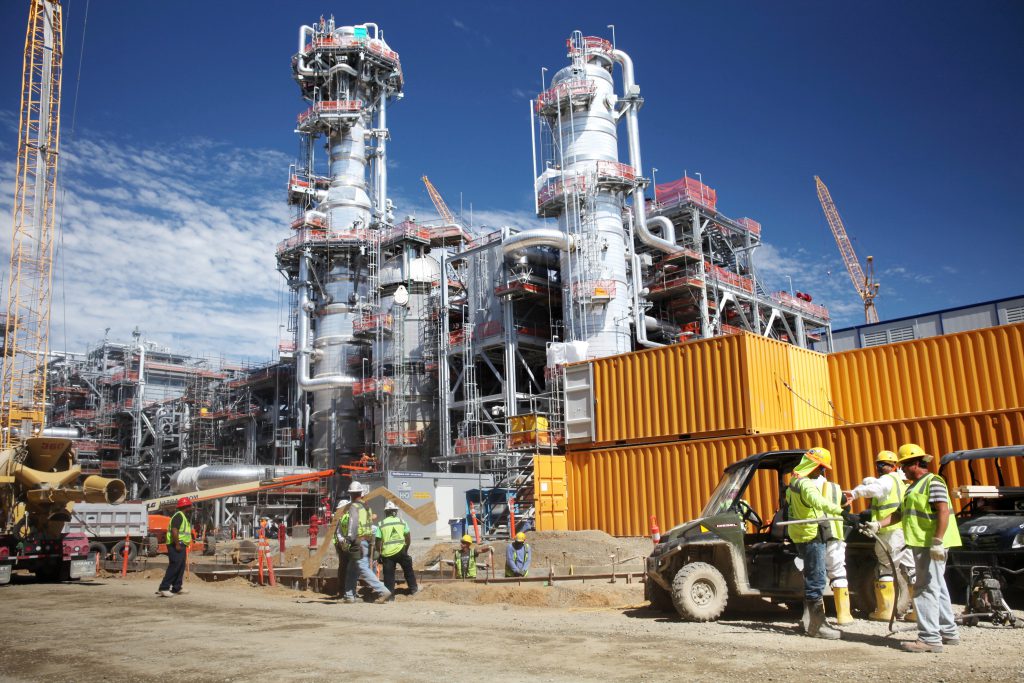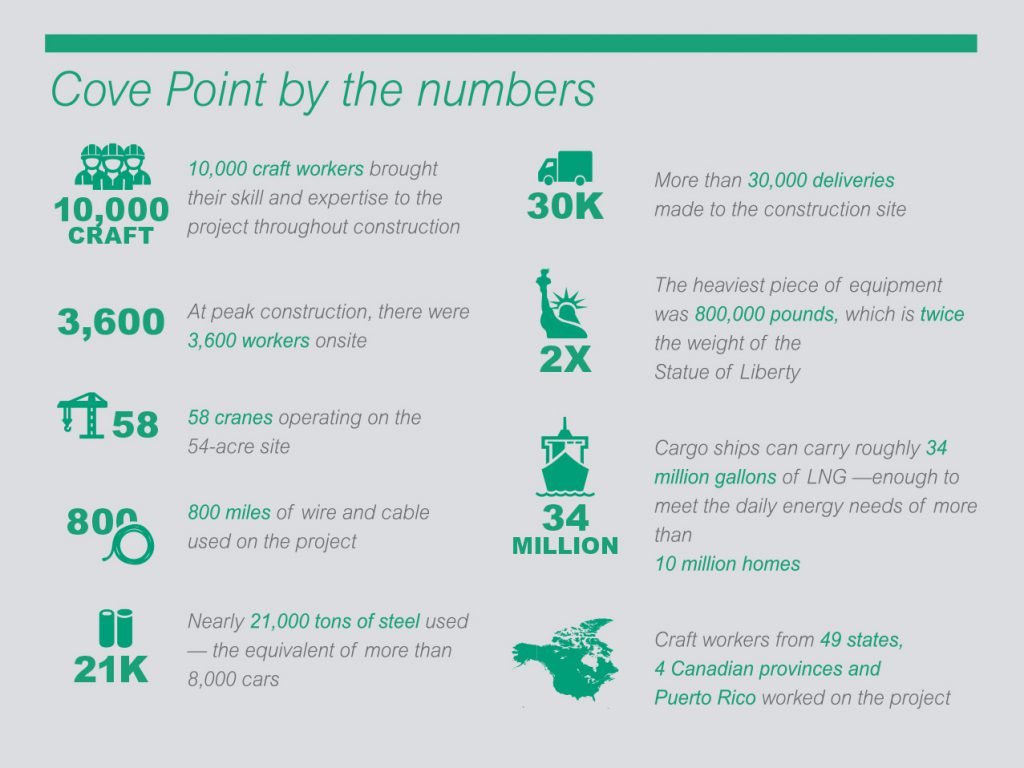20,800 tons of structural steel, 5.4 million linear feet of electrical cable,58 cranes on a 54-acre site,675 drilled shafts, 3,600 workers, 30,000 deliveries, nearly 20 million hours of work.
In the small town of Lusby, Maryland, “One Cove Point” refers to the team responsible for the construction of Cove Point, the first liquefied natural gas (LNG) export facility on the east coast of the U.S. — attracting significant attention across the global energy market.
In its more than 130-year history, Kiewit hasn’t backed away from a challenge and this project was no different. In April 2013, a joint venture of IHI E&C International Corporation and Kiewit Energy Group Inc. was selected by Dominion Energy, Inc. as the engineering, procurement and construction (EPC) contractor for the project.
“A first-of-a-kind project like this may only come around once a generation, if it all,” said Bill Bodnar, project director for Kiewit. “We were extremely excited by the challenge, which was naturally a motivating factor for our entire team.”
The scope of work included the addition of a 5.25 million metric tons per annum (MTPA) LNG export facility at Dominion’s existing import facility, which has been in operation since 1978. Specifically, this included the construction of a feed-gas receiving area, pretreatment area, liquefaction unit and a new 130-megawatt power plant. Tie-ins to the existing facility, enhancements to the marine terminal and the relocation of infrastructure were also completed. To insulate adjacent neighborhoods from noise, a 60-foot high sound wall around the perimeter of the terminal was also included in the scope.
Adding to the complexity of the project, all of this needed to be built within a roughly 54-acre site — the smallest footprint in the U.S. for a project of this size.
“The Dominion Energy Cove Point export terminal helps meet the global demand for cleaner fuel sources, while bringing substantial economic benefits to the local community,” said Jim Strohman, construction director for Dominion. “It was a huge undertaking from a construction perspective, however, we all pulled together and persevered to build a quality facility.”
One mega job, six segments
The project team was organized into “segments” with dedicated “segment managers” that reflected different areas of the facility and core functions, including anchor bolts down/underground, pre-treatment, liquefaction, site services, testing and tie-ins, and power block.
This approach allowed segment managers to focus on specific areas and break the work down to the smallest component possible without becoming overwhelmed by the overall magnitude of the project. It also helped to keep communication lines open.
“On such a large project, good communication is so important, including making sure that the right people are at the right meeting,” said John Huber, operations manager for Kiewit. “What one person is doing may affect hundreds.”
The main cryogenic heat exchanger (MCHE) has a crucial role in the LNG process, cooling warm gas into a liquid state.
54 acres in all
To overcome the small size of the construction site, the project team devised a strategy to coordinate the locations and facilities that were needed to plan, stage and build the work. A dedicated site logistics team was tasked with the efficient, effective movement of people and materials.
“The entire process was much like building a small city from the ground up,” said Brian Watkinson, site services segment manager for Kiewit.
Accommodations were made to support the movement of thousands of workers and tons of materials and equipment, as well as core functions like office space, laydown yards and maintenance centers. These arrangements required meticulous analysis and planning for special traffic signals, off-site parking, bus transportation, water stations, lunchrooms, wayfinding signage and more.
As Watkinson explains, keeping a close eye on the construction schedule was critical in keeping operations running smoothly.
“The construction schedule and quantities were used to generate a footprint for what logistically needed to be done,” he explained. “Our first step was to understand the magnitude of the work and how it would change over time, including volume of materials and where they were sourced, as well as preparing for peak workforce levels.”
Ultimately, construction operations spanned multiple locations in southern Maryland, along with steel fabrication shops in Wisconsin and engineering teams in Houston and Kansas City. In addition to the construction terminal in Lusby, an off-site area was developed for administrative, onboarding, training and warehouse activities. Several miles south of the terminal, on property adjacent to the Patuxent River, a temporary pier was built to receive shipped-in materials.
Once the facilities were in place, the focus shifted to monitoring on-site logistics through a centralized command center. To monitor activity and boost efficiency, high-definition cameras were mounted on tower cranes and access roads throughout the construction site. All truck deliveries — totaling more than 30,000 — were scheduled through the command center, which prevented congestion and ensured on-time delivery of materials to crews. This centralized process also helped reduce congestion on nearby roads, a concern to local residents and businesses.
Of all the on-site activities, the presence of 58 cranes on a roughly 54-acre site presented the most unusual challenge.
The crane management program was modeled after a traffic control system at an airport. Similar to the flight pattern of a plane, each crane had a computer-aided design that showed its turning radius and an operational zone that did not overlap with other cranes. Specially trained zone coordinators were assigned to each crane, much like an air traffic controller.
“We put structured processes behind everything we do. Each and every day, we move a small city in and out of the jobsite and no one thinks twice about it. It’s a routine part of business and that’s exactly how we want it to be,” said Watkinson.
100,000 training hours
Training programs at Cove Point came in all shapes and sizes. First and foremost, the project focused on safety-related training, which was provided to every new person on the project as part of orientation. Using a three-story scaffolding apparatus, workers participated in hands-on fall protection training learning different ways to safely tie off when working at heights. Workers completed more than 2,100 hours of signalman training to ensure that everyone maneuvered safely through busy construction sites.
New training initiatives were driven by the design of the facility, the small footprint of the construction site, and the amount of industrial and heavy pipe that needed to be installed. For example, the project adopted an alternative method for getting pipe installed into racks using bull rigging techniques.
“On other projects, pipe might be installed in a ‘pancake’ style where you install a first level and then stack the second, third, etc., on top,” Huber said. “Bull-rigging allows you to install pipe between levels so that you aren’t potentially holding up work waiting for pipe to be fabricated and delivered onsite to install in a sequential manner.”
In total, thousands of workers and employees benefitted from training programs, which totaled more than 124,000 hours.
“Cove Point was an enormous project that was very fast-paced and engineering-intense,” said Bodnar. “Even though the job was very demanding, we didn’t want to lose sight of training and professional development opportunities that added value to the project and individual career growth.”
6 Miles of Superloads
As part of its scope of work, Kiewit was responsible for the procurement of specialized, engineered equipment needed to liquefy natural gas, one of the main functions of the new terminal. Since key equipment suppliers were located across the globe, intricate plans were needed to get this equipment to site.
In order to deliver equipment via barge, a temporary pier and trestle were constructed next to the Thomas Johnson Bridge at Solomons Island. Improvements were made to existing roadways, including grading and paving work. To accommodate cargo heights of up to 30 feet, existing overhead utilities, carrying telecommunication, power and cable wires, were relocated underground.
Out of more than 70 planned superloads, transport of the main cryogenic heat exchanger (MCHE) — more than 150 feet in length and 19 feet in diameter — was the most complex. The process of aligning cargo specifications, setting the barge and cranes for lift operations, modeling vehicle turn radiuses, securing permits and constructing the foundation for the MCHE required 18 months of planning. Moving the MCHE from the barge to the terminal was completed in a 5-hour time period on a 6.2-mile route.
“The MCHE reflects a monumental investment and countless hours of engineering, manufacturing, planning and transporting,” said Jesus Mejas, senior trade compliance manager for Kiewit. “We took extremely calculated measures to eliminate any risks of damage, which could have derailed the entire project.”
In total, there were more than 33 barge loads hauling 75 pieces of equipment. The pier was dismantled after deliveries were completed. In addition to planting grass seed, Dominion is restoring a natural oyster bar that is many times larger than the original area that was impacted.
One hub for millions of data
New technology and project controls helped the team adopt a data-driven mindset, focusing on the use of the best available information as soon as it was available to keep construction progress on track. With more than a million data points to manage and hundreds of employees that needed to access the information and customized dashboards, this was no easy feat.
“One key driver of our success has been the non-negotiable use of new technology. We could have never managed the data, especially in real time, without the scalability of these tools,” Bodnar said. “Our approach went well beyond reporting and was a means for timely decision-making and optimized operations.”
The use of a dedicated “project controls team” helped to transform data into meaningful, actionable information. Since detailed engineering drawings were being finalized simultaneously with construction, it was important to streamline processes while also making sure that crews understood the work. A live data feed with the quantities associated with the drawings flowed directly to crews, informing them of the work they needed to do. As crews completed the work, they reported it back through the system — which was automatically incorporated in the schedule and a detailed forecast. If changes or updates to engineering drawings were made, it was reflected seamlessly across quantity management, schedules and forecasts.
As a result, various segments and functions of the project were all in sync, vastly improving efficiency. It allowed the team to shift from monthly to weekly schedule updates, converting a four-day process into a four-hour task. It also provided insight into the big picture of construction progress with the flexibility to drill down to specific segments and crews. For example, a superintendent in the power block segment could quickly see how many workers were needed on their crew over the next week, the next month and to finish the work.
The project controls team also developed a predictive analytics tool known as the tsunami index, which compared the existing workforce to the number of workers needed to complete the work. Given the wide range of skilled trades — such as carpenters, ironworkers, electricians and sheet metal workers — and the large volume of work, the index quickly became an invaluable management tool.
“If the index showed a significant gap in the number of electricians you have and will need, and the gap continues to widen over the next six months, we proactively addressed and shifted resources,” said Jon Eggleston, director of engineering and analytics for Kiewit. “Prior to the index, there was a tendency to overestimate what could be completed in the near term; now we have great, useful data to help focus on critical work, keeping us on track.”
Due to the small size of the construction site, the sheer number of workers in a given area had the potential to disrupt overall operations. To better manage the issue, a worker density tool was developed. Based on a threshold of the minimum square feet per worker, the tool combined the construction schedule with a detailed map of the square footage within the site to depict worker density. If specific areas were getting congested, potentially affecting productivity, quality and safety, decisions could be made to alter the location or timing of specific activities.
Second to none
The Cove Point team powered through a multitude of challenging scenarios at Cove Point.
“The tenacity of the team — taking the initiative to learn, collaborate and find solutions — was second to none,” said Danielle Kensinger, Kiewit’s Human Resources manager. “When you are in the thick of it, it was overwhelming at times, but then you look back and realize just how amazing this project and team were.”
For Kiewit Field Engineer Molly Halpin, Cove Point was her first job after college.
“Cove Point has taught me the importance of thinking on my feet and working with a sense of urgency. There was never a time where we were not working full throttle, coordinating with other segments, getting modifications made to access work areas, or meeting deadlines for pipe installations so ironworkers could build the next sequence of steel.”
The more seasoned team members also valued their experience at Cove Point.
“It was gratifying to see the young people come through the project and seeing them learn. Hopefully you can impart a little wisdom on them and they can become better than you. That should always be the goal for us,” said Huber, who has more than 20 years of experience at Kiewit.
As for Dominion, they are to proud see the project come to fruition and begin serving their customers.
“With the level of focus from all levels of the team, we are certainly well-positioned to do so,” said Strohman. “It’s been an amazing journey.”














